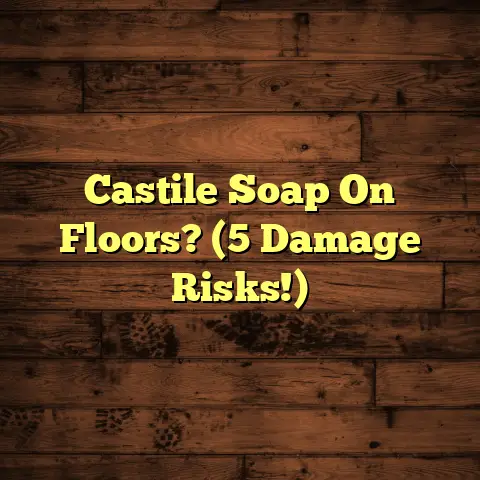Remove Water Based Paint From Vinyl? (2 Dangers!)
Ever think about future-proofing your home? I do, all the time.
As a flooring contractor, I see how much difference proper maintenance makes.
It’s not just about keeping things looking nice; it’s about preserving your home’s value.
Think about your floors, especially vinyl. It’s a popular choice, but it needs the right care.
Today, we’re diving into a tricky situation: removing water-based paint from vinyl.
Trust me, it’s not as simple as grabbing a sponge. There are definite dangers involved.
Let’s get into it, shall we?
Section 1: Understanding Vinyl Flooring
So, what is vinyl flooring, exactly?
Basically, it’s a synthetic material made from polyvinyl chloride (PVC) and other compounds.
It comes in two main forms: * Luxury Vinyl Tiles (LVT): These are individual tiles that can mimic the look of stone, wood, or ceramic. * Vinyl Sheets: These come in large rolls, offering a seamless look.
Vinyl is a superstar in modern homes, and for good reason. I’ve installed miles of it!
Here’s why homeowners love it:
- Durability: It can withstand heavy foot traffic and resist scratches and dents.
- Cost-Effectiveness: It’s generally more affordable than hardwood or tile.
- Ease of Maintenance: A quick sweep and mop usually do the trick.
But here’s the catch. Even though vinyl is tough, it’s not invincible.
Inappropriate substances, like water-based paint, can cause problems.
I’ve seen it firsthand, and it’s not pretty.
Paint spills happen, I get it. The key is knowing how to deal with them without causing damage.
Section 2: The Nature of Water-Based Paint
Let’s talk paint. Water-based paint is exactly what it sounds like: paint where water is the main solvent.
It’s made up of pigments, resins, additives, and, of course, water.
It’s a go-to for many DIY projects, and I use it on plenty of jobs myself.
Why is it so popular?
- Low VOCs: It releases fewer volatile organic compounds, making it more eco-friendly.
- Easy Cleanup: Soap and water are usually all you need.
- Fast Drying Time: You can often apply multiple coats in a single day.
But here’s where the good news ends, especially when it comes to vinyl.
While water-based paint is easy to clean up when it’s wet, it can be a real pain when it dries on vinyl.
The paint can seep into the textured surface of the vinyl, making it difficult to remove completely.
Plus, certain pigments can stain the vinyl, leaving a lasting mark.
I’ve seen cases where homeowners tried to wipe up a spill, only to spread the paint further and create a bigger mess.
The interaction between the paint and vinyl isn’t always obvious right away. Sometimes, the damage only becomes apparent after you’ve tried a few cleaning methods.
That’s why understanding the nature of water-based paint is crucial before you even think about removing it.
Section 3: The First Danger – Chemical Reactions
Okay, let’s get to the nitty-gritty: the dangers of removing water-based paint from vinyl. The first big one?
Chemical Reactions.
This is where things can get seriously dicey.
Many solvents or removal agents can cause irreversible damage to vinyl surfaces.
I’m talking discoloration, warping, and even degradation of the material.
Think about it. Vinyl is a plastic. Certain chemicals can react with that plastic, breaking it down or altering its appearance.
I’ve seen floors where people used the wrong cleaner and ended up with a bleached-out spot or a sticky residue that wouldn’t go away.
Here are some common household items and chemicals that people often mistakenly use for paint removal and their potential effects on vinyl:
| Chemical | Potential Effect on Vinyl |
|---|---|
| Acetone | Can dissolve the vinyl, causing it to become sticky, warped, or discolored. |
| Bleach | Can cause discoloration or fading of the vinyl, especially on colored or patterned floors. |
| Ammonia | Can damage the surface of the vinyl, leading to a dull or cloudy appearance. |
| Nail Polish Remover | Contains solvents that can damage the vinyl, similar to acetone. |
| Paint Thinner | Can soften or dissolve the vinyl, leading to permanent damage. |
| Strong Alkaline Cleaners | Can strip the protective coating on the vinyl, making it more susceptible to stains and damage. |
| Abrasive Cleaners | Can scratch the surface of the vinyl, dulling its appearance and making it more prone to dirt and grime buildup. |
| Isopropyl Alcohol | Can cause discoloration or fading of the vinyl, especially with prolonged or repeated use. |
Important note: This is not an exhaustive list, and the effects can vary depending on the type of vinyl and the concentration of the chemical.
I had one client who tried using acetone to remove paint.
Big mistake! The vinyl ended up with a permanent, dull patch.
The cost to repair it? Way more than if they’d called a professional in the first place.
Before you reach for any cleaning product, always read the label and check if it’s safe for vinyl.
When in doubt, test it on a small, inconspicuous area first.
Trust me, a little caution can save you a lot of headaches (and money) down the road.
Section 4: The Second Danger – Physical Damage
Now, let’s move on to the second big danger: Physical Damage.
Even if you avoid harsh chemicals, you can still mess up your vinyl floor during the paint removal process.
The main culprit here is using abrasive tools or harsh scrubbing methods.
Think about it. Vinyl, while durable, is still susceptible to scratches and tears.
If you start scrubbing with a rough sponge, steel wool, or a stiff brush, you’re basically asking for trouble.
I’ve seen floors with swirl marks and scratches all over them because someone went a little too hard with the scrubbing.
It’s like trying to sand down a delicate piece of furniture with coarse sandpaper.
You might get the paint off, but you’ll also ruin the finish.
Another common mistake is using sharp tools to scrape off dried paint.
A razor blade or a metal scraper might seem like a quick fix, but they can easily gouge or tear the vinyl.
I remember one job where a homeowner tried using a putty knife to remove paint splatters.
They ended up creating a series of shallow cuts in the vinyl that were impossible to repair.
The entire floor had to be replaced.
The key here is to use gentle techniques and appropriate tools specifically designed for vinyl care.
Soft cloths, plastic scrapers, and specialized vinyl cleaners are your best friends.
Remember, patience is key. It’s better to take your time and remove the paint gradually than to rush the process and risk damaging your floor.
Section 5: Safe Methods to Remove Water-Based Paint
Alright, so we’ve covered the dangers.
Now, let’s talk about how to safely remove water-based paint from vinyl.
I am going to give you a comprehensive guide to safe methods for removing water-based paint from vinyl without causing harm.
Here’s my step-by-step guide:
-
Act Fast: The sooner you address the spill, the easier it will be to remove. Fresh paint is always easier to clean than dried paint.
-
Gather Your Supplies: You’ll need:
- Warm water
- Mild dish soap
- Soft cloths or sponges
- Plastic scraper or putty knife
- Vinyl floor cleaner (optional)
- Clean, dry towels
-
Prepare the Area: Gently blot up any excess wet paint with a clean cloth. Avoid wiping, as this can spread the paint.
-
Warm Soapy Water: Mix a few drops of mild dish soap with warm water. Dip a soft cloth or sponge into the solution and gently wipe the paint stain.
- Tip: Always use a clean part of the cloth to avoid spreading the paint around.
-
Gentle Scraping: If the paint is dried, use a plastic scraper or putty knife to gently lift the paint off the vinyl.
- Tip: Hold the scraper at a shallow angle to avoid scratching the floor. Work slowly and carefully.
-
Vinyl Floor Cleaner: If warm soapy water isn’t enough, try a specialized vinyl floor cleaner.
- Tip: Always test the cleaner on a small, inconspicuous area first to ensure it doesn’t damage the vinyl.
-
Steam Cleaning: A handheld steam cleaner can be effective at loosening dried paint without harsh chemicals.
- Tip: Keep the steam cleaner moving and avoid holding it in one spot for too long.
-
Magic Eraser: A melamine sponge, commonly known as a magic eraser, can be used to gently rub away stubborn paint marks.
- Tip: Use it sparingly and test it on a small area first, as it can be slightly abrasive.
-
Baking Soda Paste: For stubborn stains, mix baking soda with water to form a paste. Apply the paste to the stain, let it sit for a few minutes, and then gently scrub with a soft cloth.
- Tip: Baking soda is mildly abrasive, so use it with caution.
-
Rubbing Alcohol: For certain types of paint, rubbing alcohol can be effective.
- Tip: Dab a small amount of rubbing alcohol on a cloth and gently blot the paint stain. Avoid rubbing vigorously.
-
WD-40: WD-40 can help dissolve certain types of paint and adhesives.
- Tip: Spray a small amount of WD-40 on a cloth and gently wipe the paint stain. Be sure to clean the area with soap and water afterward to remove any residue.
-
Rinse and Dry: After removing the paint, rinse the area with clean water and dry it thoroughly with a clean towel.
Important Considerations:
- Test First: Before using any cleaning method on the entire surface, test it on a small, inconspicuous area to ensure it doesn’t damage the vinyl.
- Avoid Abrasives: Never use abrasive cleaners, scouring pads, or steel wool, as they can scratch the vinyl.
- Gentle Pressure: Use gentle pressure when scrubbing or scraping to avoid damaging the floor.
- Multiple Attempts: Some stains may require multiple attempts to remove completely. Be patient and persistent.
- Professional Help: If you’re unable to remove the paint stain yourself, consider hiring a professional cleaning service.
Here’s a quick table summarizing the safe methods:
| Method | When to Use |
|---|---|





